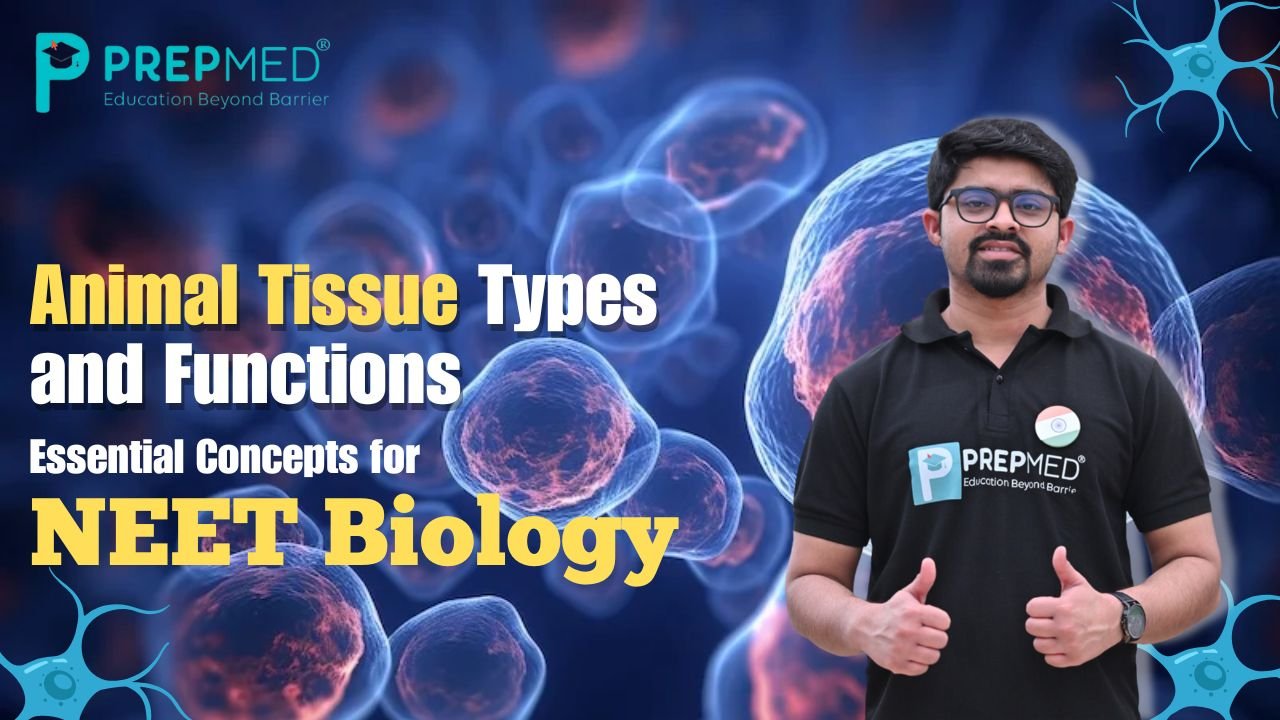November 08, 2024
Animal Tissue Types and Functions: Essential Concepts for NEET Biology
Animal tissue is a fundamental concept for NEET biology. Understanding the various types of animal tissues and their different functions in the human body is vital to grasp the concept of how the animal body works and the various organ systems functions. Mastering this concept of animal tissues is crucial as it will help you to understand the further complex animal physiology.
Animal tissues are a group of packed cells that perform together some specific functions essential for the body. Understanding the different types of animal tissues and their specific functions is very important for the students who are aiming for exams like NEET. Let’s get started with the discussion.
Types of animal tissues:
There are 4 different types of animal tissues: epithelial tissue, connective tissue, muscular tissue, and nervous tissue. Within these types, there are many subtypes which have specialized functions. Each of these tissues has separate functions, thereby contributing to the overall health of the body. Epithelial tissue is mainly essential as it is involved in lining the important body cavities and organs whereas connective tissue, as the name suggests, supports and connects other tissues and organs. Let’s learn them in detail:
1. Epithelial Tissue: Also known as epithelium, this tissue has a layer of thin, continuous, and densely placed cellular layer. This tissue has no blood vessels. Skin is an epithelial tissue.
Function:
· This tissue is responsible for covering the surface of the body and providing an outer lining to the internal body cavities, blood vessels and organs. Its main functions are- protection, absorption, and secretion.
· Epithelial tissue provides touch and taste sensation mainly, as this is facilitated by the epithelial cells present on the surface of skin and tongue.
Types of Epithelial tissue:
· Simple Epithelium: It has a singular layer of cells and it provides a lining to the ducts and cavities. Found in the alveoli of lungs.
· Simple Squamous Epithelium: It is composed of thin and flat-shaped cells and are found in areas like the lining of blood vessels.
· Stratified Squamous Epithelium: Several layers of cells responsible for providing protection to the body against friction and wear and tear. Present in the skin.
· Columnar Epithelium: It has tall, column-shaped cells and are found in the inner lining of the intestine where secretion and absorption occurs.
· Ciliated Columnar Epithelium: It is composed of cilia (thin hair like projections), found in the respiratory passage enabling mucus movement.
· Cuboidal Epithelium: It has cube-shaped cells, found supporting the ducts of the salivary glands and kidney tubules thereby providing support.
· Glandular Epithelium: Glands such as salivary glands and sweat glands, responsible for secreting chemicals.
· Compound Epithelium: It has several layers of cells and its main function is to provide protection against chemical and mechanical stress besides having a separate function of secretion and absorption. Found in the pharynx, inner linings of the salivary gland and buccal cavity.
2. Connective Tissue:
Connective tissue is made up of a non-living extracellular matrix and living cells.
Function:
· Connective tissue is responsible for binding and supporting other types of tissues and organs.
· It also provides a cushion like structure to the joints and transports the nutrients required by the body.
Types of connective tissue:
· Dense Connective Tissue: It is responsible for proving strength, support, and flexibility to the body. Its types are:
a) Dense Regular Connective Tissue: Forms the tendons (bone to bone) and ligaments (muscle to bone)
b) Dense Irregular Connective Tissue: Found in the dermis layer of the skin and provides the required structural strength.
c) Elastic Tissue: It facilitates stretching and is present in large arteries.
· Loose Connective Tissue: It is responsible for providing strength and elasticity to the tissues and organs. Its various types are:
a) Areolar Tissue: Found in skin, organs, and nerves and is responsible for binding and supporting tissues.
b) Adipose Tissue: Provides cushioning, support, and insulation to the vital tissues and organs like the abdominal cavity and kidney and is responsible for storing energy in the form of fats.
c) Reticular Tissue: Found in spleen and bone marrow. Responsible for forming a supportive network in the lymphoid organs.
· Cartilage: It has a gelatinous matrix-like substance and is composed of chondrocytes. Provides support between joints and respiratory passages. It has 3 types:
a) Hyaline Cartilage: Provides flexibility and support. Present in the nose and ends of long bones.
b) Elastic Cartilage: Present in ear and epiglottis. Maintain shape of structures and enable flexibility between various structures.
c) Fibrocartilage: Found in intervertebral discs and pubic symphysis and provides strong support.
· Bone: Bone is composed of osteocytes embedded in a collagen-filled matrix. It provides the main structural support and safeguards the vital organs. It has two types:
a) Compact Bone: It is not only dense, but also hard and strong and forms the outer covering of the bones.
b) Spongy Bone: Present in the long end of the bones and is porous in nature.
· Blood: It is a fluid-filled connective tissue that has red blood cells, white blood cells, and blood platelets in a liquid matrix called plasma. Responsible for transport of essential gases, nutrients and minerals throughout the body. It has 3 types of cells:
a) Red blood cells (Erythrocytes): Transports oxygen.
b) White Blood cells (Leukocytes): Enables the body to defend against infections.
c) Blood Platelets (Thrombocytes): Helps in blood clotting.
· Lymph: It is the fluid that circulates throughout the lymphatic system. Maintains the overall fluid balance in the body.
3. Muscular tissue: The tissue responsible for the overall movement of the body is muscular tissue. Muscles have a special property of contraction and relaxation. Its types are:
· Skeletal Muscles: Forms the supportive framework of the body. It is a voluntary muscle, responsible for supporting body movements.
· Smooth Muscles: Responsible for performing peristalsis and vasoconstriction, it is an involuntary muscle and is found in walls of intestines and blood vessels.
· Cardiac Muscles: Present in heart and responsible for circulating blood and pumping heart, these muscles are involuntary in nature.
4. Nervous tissue: Nervous Tissue makes up the central nervous system. Responsible for conducting electrical impulses in the body, facilitates communication between the different body parts and the brain, and controls vital functions of the body. It has neurons (which are the structural and functional unit of a nervous system) and glial cells.
It has neuroglia which is a special type of cell found in the brain and spinal cord.
Various types of Neurons are:
· Sensory Neurons: Responsible for detecting stimulus.
· Motor Neurons: Sends motor signals to various muscles.
· Interneurons: Binds the sensory and motor neurons and helps in processing information.
FAQS: Animal tissue
1. How many types of animal tissues are there?
There are four different types of animal tissue, epithelial, connective, nervous, and muscular tissue.
2. Is connective tissue mesodermal or endodermal in origin?
Connective tissue is mesodermal in origin.
3. What is the main function of epithelial tissue?
It is mainly concerned with protection by lining the vital internal organs and cavities. Epithelial tissue also performs secretion and absorption.






